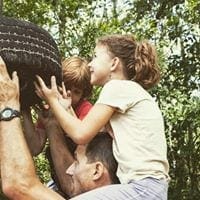We’ve all heard the terms: Helicopter Parent, Zamboni Mom, Lawnmower Parent. These derogatory labels are slapped onto folks who want to pave the way for their children. They hover near their kids and smooth their journey so as not to be injured, upset, or frustrated. It’s what a “good” parent does, right? Makes the world a safe, happy place for their child? Removes obstacles in way of their child’s success?

What we might strive to do, instead, is to build a culture of reasonable risk-taking. At home, at school, on the playground, and even in yoga class, children can be allowed to explore risky play in a supervised way. Benefits to risky play include:
- Practicing self-reflection and independent thinking: When encountering a challenging situation, a child has the opportunity to practice problem-solving. Should I jump off this log? What could happen if I do? I did it – how did it feel? What will I do next time? Reflecting on the process and outcome builds independent thinking and strategic risk-taking skills.
- Improving strength and safety awareness: In the book, Balanced and Barefoot, “In order to stimulate the senses and develop healthy motor skills, children need the opportunity to take reasonable risks. A child’s neurological system was designed to seek out the sensory input it needs on its own in order to reach the next developmental level. By taking daily risks, children start to develop age-appropriate strength, coordination, and good body awareness. On the other hand, when we consistently keep children from taking risks, we start to see some delays in sensory and motor development that may not have been an issue if they had been given daily exposure to these experiences. This can lead to poor spatial awareness and in essence, without an efficient amount of exposure to risk-taking, children can become more accident-prone and unsafe in the long run.”
- Social skill development: For our kids, risk-taking is often a group project, and talking through the possibilities is a social skill. They learn to balance assertiveness with empathy. Just sharing an opinion in a peer group may be a risk, socially. So providing guidance and situations where they must confront their peers in a reasonably risky situation is crucial to social skill development.
- Build confidence: How good do you feel when you accomplish something that felt overwhelming? Why in the world would we take that feeling away from our children? Trying and failing. Getting up when you fall down. Grit. Resilience. “It’s important that kids learn the excitement of success, the coping skills needed to move through failure and frustration, and the perseverance to try and try again, even if it is uncomfortable and hard.” (Balanced and Barefoot)
- Learning responsible risk-taking: Would you rather your child explore their risk tolerance as a toddler or as a teenager? As kids grow up, the decisions about risky behavior they have to make on a daily (hourly) basis increase exponentially. Let’s allow our children to explore their bodies and their world while they are young so when life-changing opportunities arise, they know how to navigate their choices and not feel pressured to do something they are not comfortable with. Let’s build their self-confidence and decision-making skills in a (somewhat) controlled environment so they are ready to face the real world.
As yoga teachers, we have a unique opportunity to help our children explore risky play in a safe environment. Teach challenging poses and serve as a guide for children to experiment with poses. Balance postures and inversions really build confidence and resilience since kids inevitably fall out of the poses. Meditation instruction builds kids’ mental clarity and teaches them to slow down their thoughts so they can focus on the task at hand. 
Life has always been fraught with risks. By giving children the time and space to explore risky and challenging play in a safe environment, we are encouraging them to develop life-long skills like problem-solving, decision making, and team building. These skills only become more critical as children develop into teens and adults when the consequences of actions become that much bigger.
Like what you read here? There’s so much MORE to explore and learn with Kidding Around Yoga. Check out our website for our live and online teacher trainings, Yoga Alliance-approved 95-hour RCYT trainings, specialty online courses, original music, merchandise, podcast, and beyond! KAY even offers a 6-hour workshop designed to teach school educators and homeschool families how to bring yoga and meditation right into their classrooms (EduKAY) and an online course specifically for families to incorporate these practices in their family’s routine (KAY in the Home)



